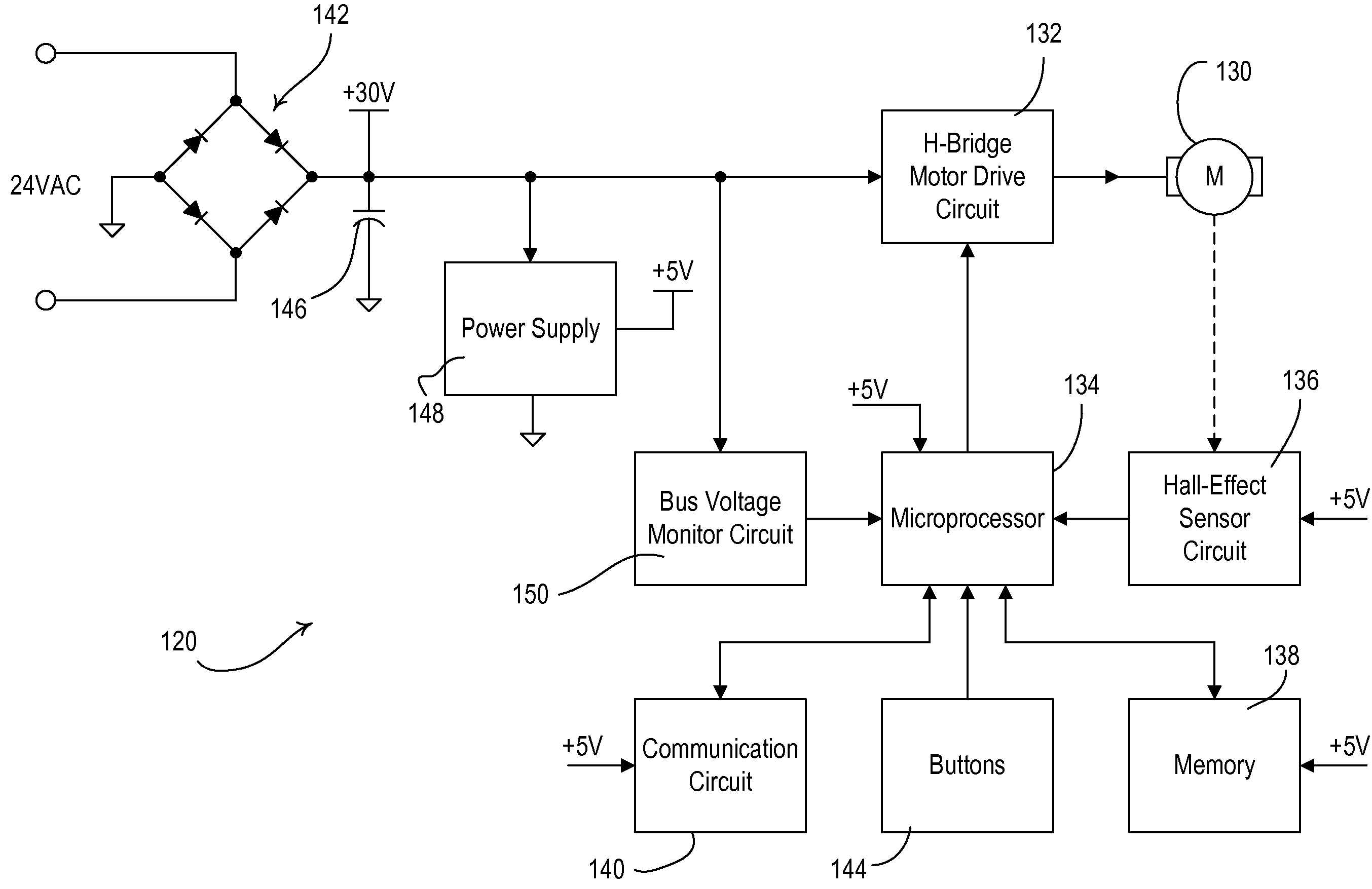Method of controlling a motorized window treatment
a motorized window treatment and motor technology, applied in the direction of dynamo-electric converter control, dc motor rotation control, instruments, etc., can solve the problems of microprocessor reset, microprocessor reset, position information maintained by the microprocessor may become inaccurate, etc., to increase the amount of current and decrease the amount of current supplied
- Summary
- Abstract
- Description
- Claims
- Application Information
AI Technical Summary
Benefits of technology
Problems solved by technology
Method used
Image
Examples
first embodiment
[0036]FIG. 1 is a simplified block diagram of the motorized window treatment control system 100 according to the present invention. The motorized window treatment control system 100 comprises a plurality of motorized window shades 110, which each comprise a flexible shade fabric 112 rotatably supported by a roller tube 114. The motorized window treatments 110 are controlled by electronic drive units (EDUs) 120, which may be located inside the roller tubes 114. The electronic drive units 120 are operable to control the shade fabrics 112 between an open position and a closed position. The EDUs 120 are coupled to a communication link 122 and are operable to receive commands across the communication link from a keypad 124. The communication link 122 may comprise a wired communication link or a wireless communication link, such as, for example, a radio-frequency (RF) communication link or an infrared (IR) communication link. The control system 100 is described in greater detail in common...
second embodiment
[0081]FIG. 10 is a simplified flowchart of a bus voltage monitor procedure 1020 executed periodically (e.g., every 572 μsec) by the microcontroller 134 according to the present invention. At step 1022, the microcontroller 134 samples the control signal BUS_MNTR. If the bus voltage VBUS is less than or equal to the first voltage threshold VTH1 at step 1024, the controller 134 stores the present duty cycle of the PWM signal driving the H-bridge motor drive circuit 132 at step 1025 and sets the OVERLOAD flag at step 1026. Next, the controller 134 begins to decrease the duty cycle of the PWM signal driving the H-bridge motor drive circuit 132. Specifically, microcontroller 134 calculates the difference VDIFF between the actual magnitude of the bus voltage VBUS and a desired overload magnitude (e.g., approximately 20 V) at step 1028, and determines the desired duty cycle DC of the PWM signal in response to the difference VDIFF at step 1030, e.g., by using the equation
DC=α·VDIFF+DCTYP (E...
third embodiment
[0083]FIG. 11 is a simplified flowchart of a bus voltage monitor procedure 1120 executed periodically (e.g., every 572 μsec) by the microcontroller 134 according to the present invention. The bus voltage monitor procedure 1120 is identical to the bus voltage monitor procedure 520 of FIG. 5B, except that the microcontroller 134 now decreases the amount of current delivered to the motor by storing the present duty cycle of the PWM signal in the memory 138 at step 1125 and then decreasing the duty cycle of the PWM signal to a predetermined duty cycle (e.g., 50%) at step 1126 rather than simply stopping the motor (i.e., at step 526 of FIG. 5B). Further, the microcontroller 134 increases the duty cycle of the PWM signal stored in the memory 138 at step 1136.
PUM
 Login to View More
Login to View More Abstract
Description
Claims
Application Information
 Login to View More
Login to View More - R&D
- Intellectual Property
- Life Sciences
- Materials
- Tech Scout
- Unparalleled Data Quality
- Higher Quality Content
- 60% Fewer Hallucinations
Browse by: Latest US Patents, China's latest patents, Technical Efficacy Thesaurus, Application Domain, Technology Topic, Popular Technical Reports.
© 2025 PatSnap. All rights reserved.Legal|Privacy policy|Modern Slavery Act Transparency Statement|Sitemap|About US| Contact US: help@patsnap.com



